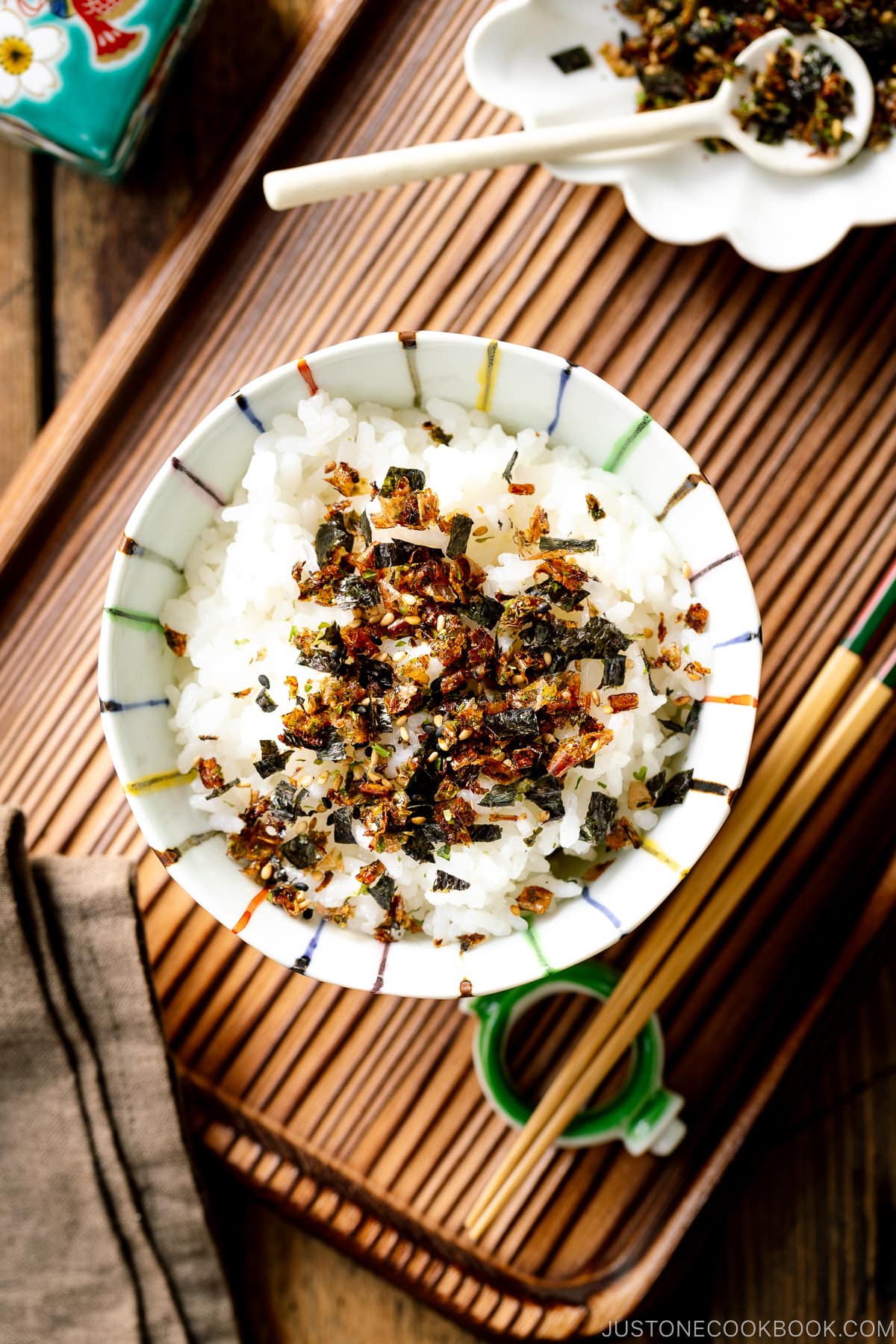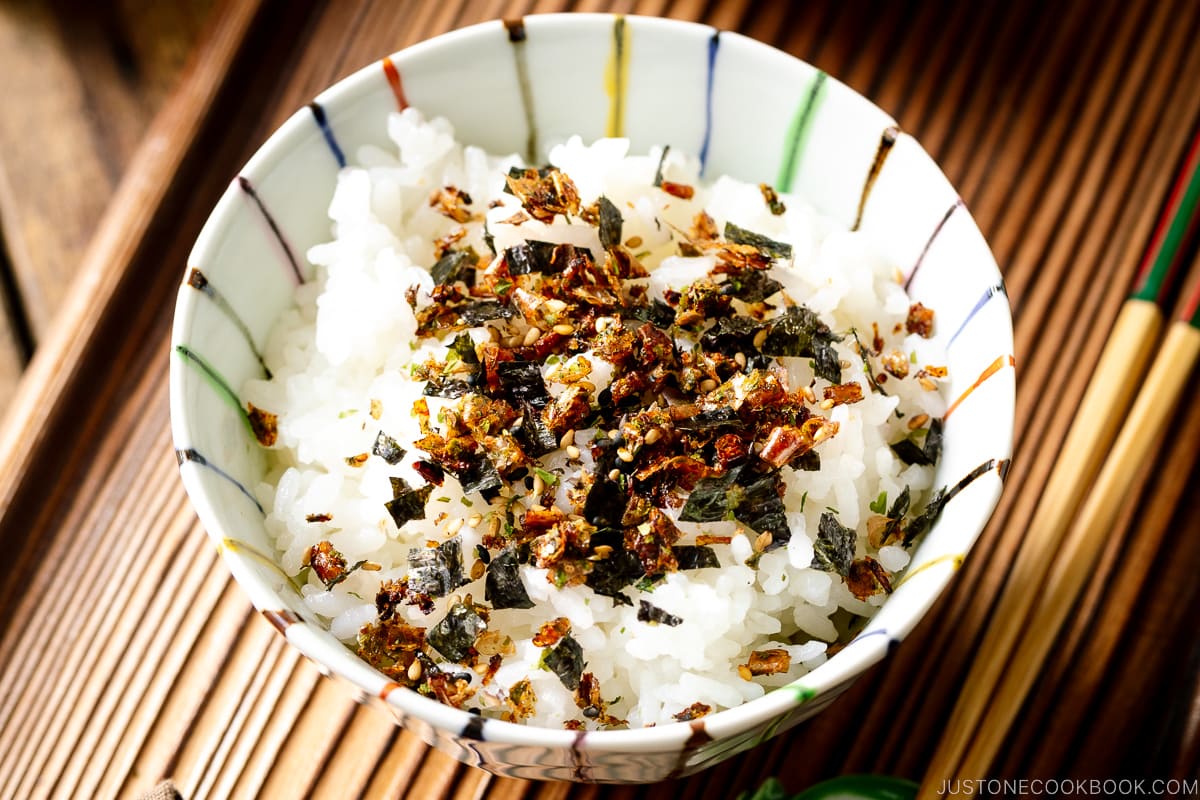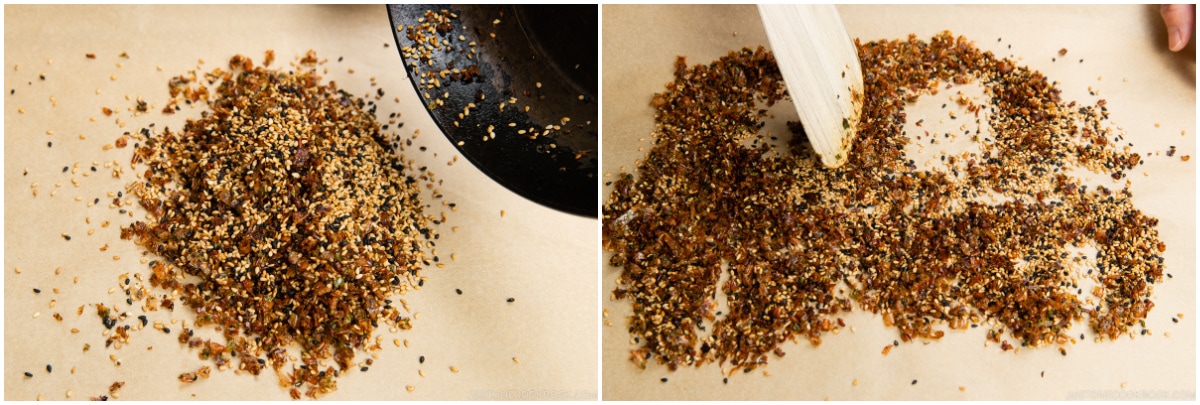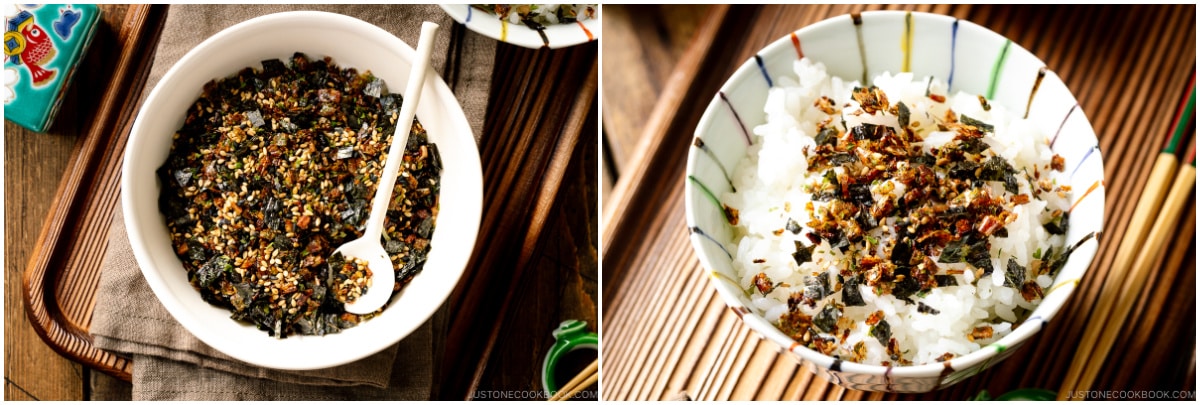Furikake is a savory-sweet rice seasoning with sesame seeds, dried fish flakes, and nori seaweed. This Japanese condiment is fabulous sprinkled on steamed rice, onigiri, udon noodles, salad, and popcorn. My recipe is a great way to repurpose leftover bonito flakes and kombu from making dashi.

Furikake (ふりかけ) is a nutty, crunchy, umami-packed Japanese blend used to season rice. Although it’s referred to as a rice seasoning, furikake is literally the salt and pepper of the Japanese kitchen. It is so versatile that you can use the seasoning to instantly perk up any bland dishes.
Table of Contents

What is Furikake?
Furikake (literally “sprinkle”) is a flaky or powered Japanese seasoning consisting of sesame seeds, seaweed, and dried seafood, meat, or vegetable. You may be familiar with the commercial variety in bottles or individual packets for kids and adults. Even Trader Joe’s has their own version of Nori Komi Furikake Seasoning!
The commercial variety contains a mixture of bonito flakes, toasted sesame seeds, nori seaweed, sugar, and salt. Some include salmon flakes, dried baby shrimp, shiso, egg, wasabi, and vegetables.

Furikake History
It goes back to the 12th century when there are records of making a salty powdered condiment consisting of dried sea bream, salmon, and shark. The current iteration was invented in the early 20th century as a nutritional supplement. It contained ground fish bones and poppy seeds to address the calcium and nutrient deficiency among the population.

How to Make Homemade Furikake
Ingredients You’ll Need
- Katsuobushi (dried bonito flakes) – You can buy it from Japanese/Asian grocery stores or online. This store carries good-quality Hana Katsuo here (ships internationally).
- Aonori (dried green seaweed) – You can buy it online here.
- Roasted sesame seeds – White and black sesame seeds taste differently, so use both!
- Nori (dried seaweed)
- Seasonings: soy sauce, mirin, sugar, salt, and sesame oil
💡 Tip: If you have reserved kombu and katsuobushi from making dashi or mentsuyu noodle soup base, you can repurpose them in this recipe! Read the details below.
Overview: Cooking Steps
This homemade furikake is really easy to make!
- Cook all the ingredients and seasonings in a frying pan until they are dry and separated.
- Let cool completely.
- Add nori seaweed and transfer to an airtight container.

Repurposing Spent Katsuobushi and Kombu
Whenever you make dashi (Japanese soup stock) from scratch, you are always left with spent kombu or katsuobushi, or usually both if you make Awase Dashi (a combination of kombu and katsuo dashi).

The best way to repurpose these spent ingredients is to make homemade furikake.
Another bonus is that you don’t have to use them right away. You can reserve spent kombu and katsuobushi in an airtight container and store it in the refrigerator for a week or in the freezer for up to a month, until you’re ready to make furikake.

Take out the portion you need and cut them into small pieces and cook in the pan with the rest of ingredients.

FAQs
Why do we need to cook the ingredients? Can we just mix everything?
There are two reasons why we cook all the ingredients and season them in a frying pan.
- Dry ingredients absorb all the delicious wet seasonings (soy sauce and mirin), and then become dry. So the ingredients will be flavored.
- If you don’t cook the mixture, loose dry seasonings such as sugar and salt will sink at the bottom of the container and you will end up with a flavorless furikake.
How long does it last?
If you include a Food Safe Silica Gel Desiccant Packet in your airtight container, you can keep the homemade furikake for 1-2 months at room temperature!

Without it, the nori and katsuobushi will start to get stale, so consume the homemade furikake within 2 weeks.

Creative Ways to Enjoy Furikake
Rich in calcium, iodine, and iron, this homemade furikake is a healthy way to season your Japanese dishes!
Furikake is absolutely wonderful on just a simple bowl of rice, porridge, or udon noodles. It’s also perfect for seasoning onigiri (Japanese rice balls), soba noodle salad, grilled salmon, or rice crackers. But don’t stop there, furikake is so versatile that I love to get creative and sprinkle it on these as well:
- Avocado – this is my favorite. Keep it simple and halve the avocado and season it with furikake as an afternoon snack. For a savory breakfast, smear your toasted bread with mashed avocado before you give it a good sprinkle of furikake. It’s a Japanese-twist on avocado toast.
- Egg – you can totally replace salt and pepper with furikake on a fried egg or soft-boiled egg when you want something more punchy.
- Popcorn – planning on binge-watching Japanese shows on Netflix or a Japanese movie night? Flavor your homemade popcorn with furikake to keep to the theme.
- Pasta – oh yes, you can top furikake on Mentaiko Pasta, cacio e pepe pasta, or any simple creamy pasta.
- Furikake Chex Mix – This is one of our family’s holiday edible treats!

A Great Holiday Gift
If you make a big batch, you can even freeze the seasoning for a month. Furikake makes a great holiday gift. Just pack the Japanese seasoning in a cute little glass jar to surprise your foodie friends and family!

Make sure to add a Food Safe Silica Gel Desiccant Packet for each jar, so your friends and family can enjoy it for 1-2 months!

Wish to learn more about Japanese cooking? Sign up for our free newsletter to receive cooking tips & recipe updates! And stay in touch with me on Facebook, Pinterest, YouTube, and Instagram.

Furikake (Japanese Rice Seasoning)
Ingredients
- ⅓ oz katsuobushi (dried bonito flakes) (or 5 2-g packets; you can repurpose ½ oz or 15 g reserved katsuobushi from making dashi or mentsuyu noodle soup base; skip for vegan)
- ½ oz reserved kombu (optional; repurpose reserved kombu from making dashi or mentsuyu)
- 1 Tbsp aonori (dried green laver seaweed)
- 3 Tbsp toasted white sesame seeds
- 1 Tbsp toasted black sesame seeds
For the Seasonings
- 1 tsp sugar (plus more to taste)
- ½ tsp Diamond Crystal kosher salt (plus more to taste)
- 1 tsp mirin
- 1 tsp soy sauce
- ½ tsp toasted sesame oil
For the Add-On Ingredients (after cooling)
- ½–1 sheet nori (dried laver seaweed)
- 1 tsp aonori (dried green laver seaweed) (optional; I added extra aonori for more color)
Instructions
Before We Start…
- It‘s important to cook the ingredients and seasonings together in a frying pan so the ingredients absorb all the seasonings and the furikake is more flavorful. If you don‘t cook it, the sugar and salt simply will sink to the bottom of the furikake jar and the flavors won‘t incorporate well into the furikake.

- In this recipe, you can repurpose the spent katsuobushi and kombu you reserved from making dashi or mentsuyu noodle soup base. Follow the suggested measurements in the ingredient list. To save the spent kombu and katsuobushi for later, you can store in an airtight container in the refrigerator for a week or in the freezer for up to a month.

- Gather all the ingredients.

To Prepare the Spent Katsuobushi and Kombu (if using)
- Gather ½ oz (15 g) spent katsuobushi. Make sure the spent katsuobushi is well drained. Cut it into small pieces with a knife.

- Slice ½ oz reserved kombu (optional) into thin strips, and then cut the strips into small pieces.

To Cook the Furikake
- In an ungreased frying pan, add ⅓ oz katsuobushi (dried bonito flakes) or the reserved katsuobushi, 1 Tbsp aonori (dried green laver seaweed), and the spent kombu (optional). Then, add all the seasonings—1 tsp sugar, ½ tsp Diamond Crystal kosher salt, 1 tsp mirin, 1 tsp soy sauce, and ½ tsp toasted sesame oil. Mix it all together.

- Turn on the stove‘s heat to medium low and cook, stirring constantly, until the katsuobushi becomes dry and flaky.

- Now, lower the heat and add 3 Tbsp toasted white sesame seeds and 1 Tbsp toasted black sesame seeds. Cook, stirring frequently, on low heat until the sesame seeds are nicely roasted and fragrant.

- Transfer the furikake to a baking sheet lined with parchment paper. Spread it out and let it cool completely.

- Once it’s cooled, cut ½–1 sheet nori (dried laver seaweed) into thin strips, and then small pieces ⅛ inch (3 mm) square.

- Add the nori pieces to the cooled furikake and mix everything together.

- Taste the furikake and adjust the seasonings by adding more salt or sugar at this step. I decided to add an additional 1 tsp aonori (dried green laver seaweed) for enhanced color and taste (optional).

- In an airtight glass jar, add one Food Safe Silica Gel Desiccant Packet on the bottom, add the furikake, and close the lid tightly.

To Serve
- Enjoy sprinkling it over steamed rice and popcorn!

To Store
- You can refrigerate it for up to 2 weeks and freeze it for up to a month without a desiccant packet. With the packet, you can keep it at room temperature for 1–2 months.
Nutrition
Editor’s Note: This post was originally published in July 2013. It has been republished on November 27, 2022, with the revised recipe, new images, and updated content with more information.























[…] the drained katsuobushi and kombu to make homemade Furikake (rice seasoning). Click here for the […]
[…] with a fine mesh sieve. Set the katsuo dashi aside for now. You can discard the katsuobushi or make furikake (rice seasonings) with the leftover […]
Hi! We really enjoyed making the new year’s soba and Furikake! It was a fun family project for us. Thank you!
Hi Sharon! I’m so happy to hear that. Thanks for trying my recipes and for your kind feedback. 🙂
I’m making this right now, right after having made your ichiban dashi recipe! I love using everything to the last drop so this recipe makes me happy. How should I store the furikake if I’m not using it right away? In the fridge? Straight into the freezer? Thanks!
Sorry! Just saw the note at the very end of the recipe. Please disregard my question 🙂
Hi Jenn! No problem. I’m so happy to hear you made this! 🙂
Hi Nami
I love your blog/website! I am Sansei and since my mother was Kibei, I find many of your recipes most natsukashii! I grew up with furikake – do you have a recipe for a shiso furikake? My family loves one I purchase called “shiso fumi furikake”. I grow both red and green shiso in my garden in Portland, OR and love to find recipes for both. thanks! Cathy
Hi Cathy! Ah, I love Yukari (another name for the same thing) too! I don’t know how to make it, but I assume you blend dried red shiso + sesame seeds + umeboshi (no seed)… should be easy to make, but I need to test the recipe… but… I don’t get red shiso here… 🙁 I think you can probably find the recipe in Japanese. Try searching Yukari. That’s more commonly used name. 🙂
You’re so right! I made furikake with my dashi leftovers, and tried it on avocado for breakfast. It’s SO delicious! Oishii!!! Thank you! 🙂
Hi Hannah! I’m so happy you tried this recipe! Yes, sprinkle on avocado for breakfast! 🙂
These are superb and so beautifully presented.
Thank you
Thank you so much for your kind words, Kevin! 🙂
Love your recipies so much!
I thought it felt like such a waste to just throw out the left over bonito after it had been used to make broth, so I’m really glad to see there is something else you can do with it there after.
Thank you so much! Yes, I don’t make it all the time, but once in a while I do. And you can also make Niban Dashi (second dashi making with the same ingredients – not as refine as first dashi, but still great for miso soup etc). Hope that helps!
I made Dashi second time but I can never know there is leftover to make homemade Furikake. I will try make it tonight. I hate waste food lol Oh btw I lost 26 pound and I feel good. Because of you thank you Nami ????
Hi Michelle! I hope the homemade furikake came out well. You lost 26 lbs, with my recipes!? How come I’m gaining more?! LOL! Congratulations! I need to lose at least 10 lbs… 🙂 I’m so happy for you!
i found this recipe yesterday and just made it. it is delicious!!!
i usually buy katsuo furikake, but this recipe is sooo easy and quick to make!
thank you so much for sharing it! no more wasted katsuobushi (^__^)
have you ever tried putting cooked somen in a pan and just tossing some katsuo furikake on it? maybe not the regular way to eat it, but definitely worth a try, if you’re in need for a quick snack/meal (^_^) (learned this from my japanese uncle in law)
Hi Miya! I’m so happy to hear you enjoyed this recipe! Yeah, no more waste, and the great part is that we can get delicious homemade furikake too!
I have not tried somen + katsuo furikake before, but I’ll definitely try! When I make yaki udon, I always sprinkle katsuobushi for additional flavor boost and it’s so delicious. So I can totally imagine this taste! Thanks for sharing! 🙂
What a great idea! I had a lot of kombu and katsuobushi left over from making a big pot of dashi and miso from your other recipes. I hated the idea of throwing them away but now I won’t have to. Your recipes are almost as lovely as you are! Thanks!
Hi Victor! You can make Niban dashi (second dashi). Some people use it for cooking (that requires dashi) or even miso soup (less sophisticated taste, but still it’s good enough with miso in it). After Nibandashi, you can make furikake too. I usually make good dashi for dishes that requires good dashi taste, but try to make nibandashi for extra dashi usage.
I mentioned how to make niban dashi in the Note section of this page:
https://www.justonecookbook.com/how-to-make-dashi/
I’m glad to hear you like this rice seasonings with leftover kombu and katsuobushi! 🙂 Thank you so much for reading my blog! 🙂
Thank you so much for your recipes. This is my first time cooking Dashi and I just cook the udon soup for my family and they loved it. Then I continue to make furikake from the Kombu and bonito. It tastes great too! I love it that there is no food waste.
Hi PingChing! Awesome! I’m so happy to hear your family enjoyed the homemade dashi and udon soup! It makes huge difference using the homemade dashi (vs. dashi powder etc). Glad you made the furikake too! Thanks so much for your kind feedback!
Very good tip,
Would you add shicimi to spice it up?
My compliments for the recipes.
Sure, definitely you can do that! Thanks for your kind words! 🙂
Wow – this sounds wonderful, will be trying this for sure. 🙂
Hi Melody! I hope you enjoy this homemade furikake. 🙂
May I know how to use this Furokake? Eat with rice or? =)
Hi Stephy! Yes you sprinkle Furikake on top of steamed rice. It’s basically a rice seasoning. 🙂
Thank you so much for this
recipe! I love recycling ingredients
Hi Jate! You’re welcome! These ingredients are too good to throw away. 🙂